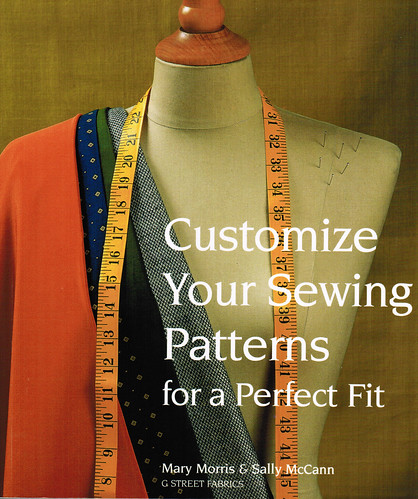
Paperback, 144 pages
Published in 2002
ISBN: 9781579903244
Suggested retail price $14.95 USD, OOP, available used on Amazon
This book is written by two of the G Street Fabrics sewing instructors. Initially I was really excited about this book but when I tried to apply the techniques, I made a huge mess of my project. I think you need to determine how your mind works, how your creative process works best in order to pick a fitting technique that will work for you. This book relies on measurements and calculating widths to add and subtract from the pattern pieces before you make a muslin. I figured this was right up my alley because I've always been great at math. Problem is that math doesn't fit into my creative process very well. I'm a fan of the pinch a little, tuck a little method. Muslins allowed me to do that. If you feel more comfortable fitting by measurement, then this is the book for you. If you prefer to pinch, tuck and pull, then get Palmer/Pletsch's Fit for Real People. I also feel like Fit for Real People addresses more fitting issues than this book. Another great source for people who like to use a little of each fitting method is the Fitting & Pattern Alteration: A Multi-Method Approach to the Art of Style Selection, Fitting, and Alteration by Liechty, Rashband, and Pottberg-Steineckert.
For the time being, I'm going to shelve this book. I may find a use for it in the future.
Book/Chapter Headings:
1. Getting Started
Basic introduction with a glossary and explanation of alteration methods, including the slash-and-pivot, wedge-slash-and-pivot, the L-slash, and the Box methods.
2. Understanding and Comparing Fitting Patterns
Explains how to determine pattern size, particularly when you would use your bust vs. high bust measurements. There is a really nice chart of all the major pattern companies and the differences in sizes for their basic bodice, sleeve, and skirt patterns. I've seen variations of these charts before but this is the most comprehensive I've ever seen. The pants pattern comparison and an additional lower body measurement chart are in the chapter about pants fitting.
3. Taking Your Measurements and Preparing the Fitting Pattern
A few nice pictures of where you should measure yourself but the best part of this chapter is the detailed measuring chart and instructions. More pictures would make this chapter gold. There are also a few line drawings demonstrating exactly where to measure a pattern piece to compare to your own measurements.
4. Fitting Problems and Solutions
Lots of pictures of REAL women wearing poorly and properly fitting clothes. Helpful but I think the Palmer/Pletsch's Fit for Real People covers this better and with many more pictures.
5. Fitting the Bodice
The authors recommend doing the bust adjustment first, and saving the shoulder, front chest and upper back adjustments for a tissue fit. I suppose this could work if you have the side seams and shoulder seams in perfect position before starting. Personally, I find that if I fix my shoulders and upper back first, the bust alteration is either not needed or not as extreme. Good illustrations of the concepts explained. There is a detailed explanation of a tissue fit as well. Again, I prefer Palmer/Pletsch's Fit for Real People because there are many more pictures and they are in color which helps highlight wrinkles in the tissues, etc. Like I said earlier, this section was a nightmare for me. After many measurements, slashes, and pivots, I had destroyed my pattern and was no closer to a nice fitting bodice. At this point, I simply skimmed the rest of the book and then shelved it. I haven't referred to it since.
The remaining chapters follow the same pattern as the above chapter: explanation of which adjustments to make first, what qualifies as a major or minor adjustment, diagrams to demonstrate whatever alteration method is recommended, and a couple pictures of the final muslin.
6. Fitting the Sleeve
7. Fitting the Skirt
8. Fitting Pants
9. Preserving and Using Your Personal Fitting Patterns
There is a nice figure showing you what a dolman vs raglan sleeve is, basque waist, princess seam, etc. The figure is very basic and leaves out quite a bit but this would be a good starting place for a beginner. This chapter also uses line drawings to demonstrate how you use your fitting pattern to make adjustments to your fashion patterns.
10.Using Your Personal Fitting Patterns as a Design Tool
This is a very basic attempt to show you that you can use your fitting pattern to design your own garment. I think the following 2 books do a much better job: Make Your Own Patterns by Rene Bergh and How to Make Sewing Patterns by Donald McCunn.
11.Next Steps and New Directions
Appendix: Finding a Fitting Buddy
Annotated Bibliography
At this time, I don't think I would recommend this book to others. I have other books in my collection that cover fitting topics more comprehensively than this book.
No comments:
Post a Comment